 Purdue University - Extension - Forestry and Natural Resources
Purdue University - Extension - Forestry and Natural Resources
Got Nature? Blog
Purdue Forestry and Natural Resources’ extension efforts over the past two years amidst the COVID-19 pandemic were recognized in the Purdue Extension Specialist Quarterly newsletter.
 The transition to virtual content brought expertise across subject matter areas, ranging from forestry and wildlife, to aquatic sciences and entomology, to the masses in the form of several video series which collectively earned nearly 150,000 views.
The transition to virtual content brought expertise across subject matter areas, ranging from forestry and wildlife, to aquatic sciences and entomology, to the masses in the form of several video series which collectively earned nearly 150,000 views.
The FNR Extension team included: Jay Beugly, Jarred Brooke, Nick Burgmeier, Barny Dunning, Diana Evans, Lenny Farlee, Jason Hoverman, Liz Jackson, Brian MacGowan, Patrick McGovern, Wendy Mayer, Charlotte Owings, Lindsey Purcell, Bee Redfield, Shelby Royal, Bob Rode, Kara Salazar, Mike Saunders, Amy Shambach, Rod Williams, Mitch Zischke, as well as frequent Entomology contributors: Elizabeth Barnes, Cliff Sadof.
The feature in the fourth quarter newsletter begins:
“While Covid caused limitations on travel and in-person events nationwide, across Indiana, many were spending more time in outdoor recreational activities, hiking, bird-watching, hunting and fishing, or managing natural resources properties. Adjusting to the pandemic, the FNR team created an innovative and team-oriented instruction approach through skill-building in video production with coordinated connection and cross-promotion of resources.
“Forestry and Natural Resources (FNR) faculty, specialists, staff, and students, with invited partners across research and Extension, delivered 45-minute Ask an Expert Facebook Live programs for 35 weeks. Programs covered many FNR specialties: Animals & Insects (bats, bird, cicadas, coyotes, deer, fish, frogs, hellbenders, moles, pollinators, salamanders, snakes, toads, turtles, and wood pests); Plants & Ecosystems (invasive plant species, hardwood ecosystems, native grasses for wildlife, conservation tree planting, rainscaping, fall food plots, and selecting, planting and inspecting trees); and Management & Operations (prescribed fires, aquatic plant and pond management, and fish and wildlife management).
Resources:
Ask An Expert Playlist, Purdue Extension – Forestry and Natural Resources (FNR) YouTube Channel
ID That Tree Playlist, Purdue Extension – FNR YouTube Channel
A Woodland Management Moment Playlist, Purdue Extension – FNR YouTube Channel
Wildlife Habitat Hint Playlist, Purdue Extension – FNR YouTube Channel
Subscribe to the Purdue Extension – Forestry and Natural Resources YouTube Channel
Wendy Mayer, FNR Communications Coordinator
Purdue University Department of Forestry and Natural Resources
Diana Evans, Extension and Web Communication Specialist
Purdue University Department of Forestry and Natural Resources
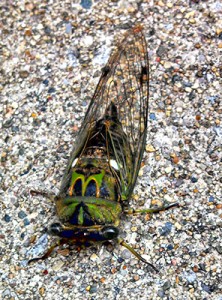 The interdisciplinary team behind The Brood X Cicada Outreach in the spring and summer of 2021 has been selected as the recipients of the Purdue Cooperative Extension Specialists’ Association (PUCESA) Team Award.
The interdisciplinary team behind The Brood X Cicada Outreach in the spring and summer of 2021 has been selected as the recipients of the Purdue Cooperative Extension Specialists’ Association (PUCESA) Team Award.
The Team Award recognizes innovative Extension programming by a team of specialists and their allied partners.
The cicada team, led by exotic forest pest educator Dr. Elizabeth Barnes, created a website, videos, social media posts, citizen science projects and more to educate the public about 17-year cicadas to prevent panic by framing the emergence as a wonder to be enjoyed and not a plague to be endured.
Cicada information ranged from myth busting – sharing that cicadas do not bite people or cause long-term harm to trees and are not “a plague of locusts,”- to general identification information, tree health, and human and animal health information related to the emergence. In addition, the team produced a poster illustrating cicadas and look-alike insects, shared jewelry and art projects, and even put on a cicada cookie decorating contest in conjunction with the Virtual Bug Bowl event.
“The Cicada Team anticipated the need for solid information for the public well in advance of the emergence of the 17-year periodical cicada,” Tom Creswell, Director of the Plant and Pest Diagnostic Laboratory, said in a letter of supporting the team’s nomination. “They did an amazing job in creating an engaging and information packed website, complete with identification aids, cicada related children’s activities, fruit tree protection information and offered a newsletter signup for more information. This allowed us to much more easily field questions related to the cicada emergency and allowed us to point to Purdue generated information with confidence in the accuracy.”
The team included personnel from the departments of Entomology, Forestry and Natural Resources, and Horticulture and Landscape Architecture as well as Purdue Extension educators, in order to craft specific messaging for nursery crop producers, foresters, fruit producers, landscapers and homeowners.
The team’s website became a source of information for the public and media as well as extension educators across the state, introducing the insect and preventing panic spraying of insecticides or the hiring of contractors selling false promises of protection. The site had nearly 23,000 unique views, while videos deployed by the team on Facebook and YouTube were viewed more than 12,000 times. The related social media campaign reached nearly 85,000 individuals.
More than 30 local and national news outlets ranging from the Indianapolis Star and South Bend Tribune to NBC, CBS, ABC, NPR, Disney Plus and National Geographic picked up on the buzz created by the cicada team. Barnes conducted 47 media interviews herself, while many other local extension educators and specialists also gave interviews to various outlets armed with information from the Cicada website.
Resources:
Emergence of the 17-year Cicada Website, Purdue Extension – Entomology
Cicada Activity for Kids, Purdue Extension – Entomology
Cicada and Their Lookalikes Poster, Purdue Extension – Entomology
17 Ways to Make the Most of the 17-year Cicada Emergence, Purdue College of Agriculture
Ask an Expert: Cicada Emergence Video, Got Nature? Blog, Purdue Extension-FNR
Periodical Cicada in Indiana, The Education Store, Purdue Extension resource center
Cicada Killers, The Education Store
Zombie Cicadas Video, Bug Bowl 2021
Subscribe to Purdue Extension – Forestry and Natural Resources YouTube Channel
Wendy Mayer, FNR Communications Coordinator
Purdue University Department of Forestry and Natural Resources
Elizabeth Barnes, Exotic Forest Pest Educator
Purdue University Department of Entomology
Join fisheries specialist Dr. Mitch Zischke and Fred Whitford from the Purdue Pesticide program as they share about pond vegetation, from what is pond vegetation and why is it useful, to how you prevent negative effects from aquatic plants and what can you do to control problem plants.
If you have any questions regarding trees, forests, wildlife, wood products or other natural resource topics, feel free to contact us by using our Ask an Expert web page.
Resources:
Aquatics & Fisheries, Playlist, Purdue Extension – Forestry and Natural Resources YouTube Channel
Ask an Expert: Pond Wildlife Management, Video, Purdue Extension – FNR YouTube Channel
Ask an Expert: Pond Management: What to Do in Winter, How to Plan for Spring, Video, Purdue Extension – FNR YouTube Channel
Aquatic Pest Management, The Education Store, Purdue Extension resource center
Pond Management: Stocking Fish in Indiana Ponds, The Education Store
Aquatic Plant Management: Identifying and Managing Aquatic Vegetation, The Education Store
Aquatic Vegetation Management, College of Agriculture – Purdue Extension
Pond and Wildlife Management, College of Agriculture – Purdue Extension
Purdue Plant and Pest Diagnostic Lab, College of Agriculture – Purdue Extension
Find your county extension educator, College of Agriculture – Purdue Extension
Purdue Pesticide Program eLearning Aquatic Pest Management Module, Purdue Pesticide Program, Purdue Extension
Part 1: Know Your Pond, Video, Purdue Extension YouTube Channel
Part 2: Selecting the Right Equipment for the Job, Video, Purdue Extension YouTube Channel
Part 3: Proper Placement of the Herbicide, Video, Purdue Extension YouTube Channel
Part 4: Stopping the Hitchhikers Boat Cleaning, Video, Purdue Extension YouTube Channel
Mitch Zischke, Clinical Assistant Professor
Purdue Department of Forestry and Natural Resources
Fred Whitford, Clinical Engagement Professor
Purdue Department of Botany and Plant Pathology
In this episode of ID That Tree, Purdue Extension forester Lenny Farlee introduces you to the flowering dogwood, which blooms in April and May, and is a great alternative to the invasive callery pear. Learn more about this small tree and its growing preferences inside.
If you have any questions regarding wildlife, trees, forest management, wood products, natural resource planning or other natural resource topics, feel free to contact us by using our Ask an Expert web page.
Resources:
ID That Tree, Playlist, Purdue Extension – Forestry and Natural Resources YouTube Channel
A Woodland Management Moment, Playlist, Purdue Extension – FNR YouTube Channel
Shrubs and Woody Vines of Indiana and the Midwest, Purdue University Press
Native Trees of the Midwest, Purdue University Press
Investing in Indiana Woodlands, The Education Store
Forest Improvement Handbook, The Education Store
Flowering Dogwood, The Purdue Arboretum Explorer
Flowering Dogwood, Native Trees of Indiana River Walk, Purdue – Fort Wayne
Lenny Farlee, Sustaining Hardwood Extension Specialist
Purdue University Department of Forestry and Natural Resources
Video series adds “spring bloom” to aid in the identification of different trees. With vivid pictures sharing what to look for regarding the leaves, bark and bloom, Purdue Extension Forester Lenny Farlee identifies these six trees and what to look for in the spring.
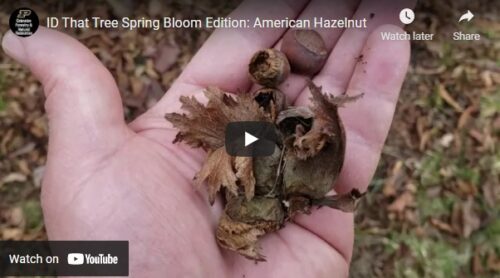 ID That Tree Spring Bloom: American Hazelnut
ID That Tree Spring Bloom: American Hazelnut
Did you know that the American hazelnut has male and female flowers? Learn about them and more about this Indiana shrub that produces a tasty treat for humans and wildlife alike in this edition of ID That Tree with Purdue Extension forester Lenny Farlee.
 ID That Tree Spring Bloom: American Plum
ID That Tree Spring Bloom: American Plum
In this edition of ID That Tree, Purdue Extension forester Lenny Farlee introduces you to one of our beautiful spring bloomers, the American Plum. Learn how to identify this great alternative to the invasive callery pear by getting to know this species, which can be classified as a small tree or large shrub.
 ID That Tree Spring Bloom: Ohio Buckeye
ID That Tree Spring Bloom: Ohio Buckeye
On this edition of ID That Tree, learn about one of the first native trees to leaf out, the Ohio buckeye. This understory tree is know by its palmate leaves and clusters of yellow/green flowers. Learn more from Purdue Extension Lenny Farlee inside.
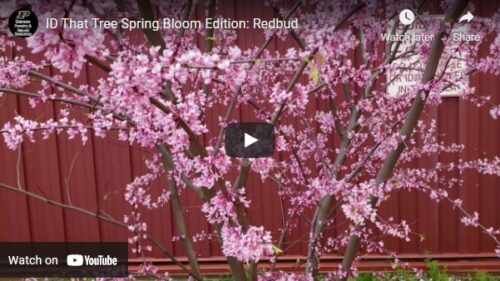 ID That Tree Spring Bloom: Redbud
ID That Tree Spring Bloom: Redbud
In this edition of ID That Tree, Purdue Extension forester Lenny Farlee introduces you to the redbud in all of its spring glory. This native Indiana species is known for its pink, lavender and even red and white flowers, which bloom in early spring.
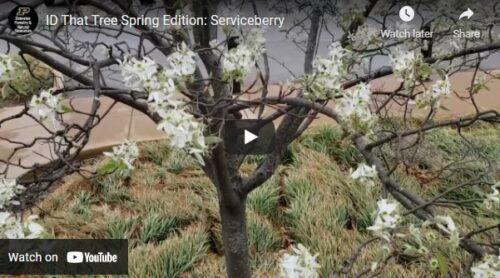 ID That Tree Spring Bloom: Serviceberry
ID That Tree Spring Bloom: Serviceberry
In this spring edition of ID That Tree, Purdue Extension forester Lenny Farlee introduces you to the serviceberry, or juneberry tree. This small native tree is known by its tiny white, or pink, flowers and by its smooth gray bark. Learn more inside.
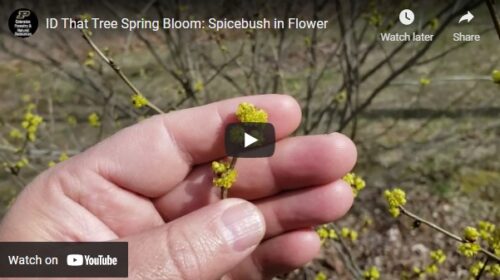 ID That Tree Spring Bloom: Spicebush in Flower
ID That Tree Spring Bloom: Spicebush in Flower
On this episode of ID That Tree, Purdue Extension forester Lenny Farlee introduces the Spicebush, a large native-Indiana shrub that brings early spring color with its clusters of small yellow flowers. This species prefers moist, high-quality soils and is common in forest understories, and brings an aromatic odor when its leaves are crushed or twigs are scraped.
If you have any questions regarding wildlife, trees, forest management, wood products, natural resource planning or other natural resource topics, feel free to contact us by using our Ask an Expert web page.
Resources:
The Education Store, Purdue Extension resource center for publications, videos and apps
The Purdue Arboretum Explorer
Shrubs and Woody Vines of Indiana and the Midwest, Purdue University Press
Native Trees of the Midwest, Purdue University Press
Investing in Indiana Woodlands, The Education Store
Forest Improvement Handbook, The Education Store
Lenny Farlee, Sustaining Hardwood Extension Specialist
Purdue University Department of Forestry and Natural Resources
Join Purdue FNR’s own professor of wildlife science, Dr. Rod Williams, along with Mike Lodato, member of the Indiana Technical Advisory Committee for Herpetology, and Nate Engbrecht, herpetologist for the Indiana Department of Natural Resources, to learn tips on the how’s, when’s and where’s of herping in Indiana, including what gear to take, where to go and what you might see in different parts of the state.
If you have any questions regarding wildlife, trees, forest management, wood products, natural resource planning, or other natural resource topics, feel free to contact us by using our Ask an Expert web page.
Resources:
What’s a Herp? Indiana Department of Natural Resources YouTube Channel
Appreciating Reptiles and Amphibians in Nature, The Education Store, Purdue Extension resource center
The Nature of Teaching, Unit 3: Reptiles, Amphibians, and the Scientific Method, The Education Store
A Moment in the Wild: Eastern Newt Video, Purdue Extension – FNR YouTube Channel
Help the Hellbender, Purdue Extension
Rod Williams, Professor of Wildlife Science
Purdue Department of Forestry and Natural Resources
Nate Engbrecht, Herpetologist
Indiana Department of Natural Resources
Mike Lodato, Member of the Indiana Technical Advisory Committee for Herpetology
Spring is here! It is the time of year for some of us to be planting new trees. In this Ask an Expert session, we welcome Lindsey Purcell, urban forestry specialist, as he teaches us how to plant and properly care for our trees. He goes over the tree selection process, including which invasive species trees we should avoid, and how to continue to take care of our trees once planted.
If you have any questions regarding wildlife, trees, forest management, wood products, natural resource planning, or other natural resource topics, feel free to contact us by using our Ask an Expert web page.
Resources:
Planting Your Tree Part 1: Choosing Your Tree, Purdue Extension YouTube Channel
Tree Planting Part 2: Planting a Tree, Purdue Extension – Forestry and Natural Resources YouTube Channel
Indiana Invasive Plant List, Indiana Invasive Species Council, Purdue Entomology
Alternatives to Burning Bush for Fall Color, Purdue Landscape Report
Invasive Plant Species: Callery Pear, Youtube, Purdue Extension
Equipment Damage to Trees, Purdue FNR Extension
Landscape Report Shares Importance of Soil Testing, Purdue FNR Extension
Lindsey Purcell, Urban Forestry Specialist
Purdue Department of Forestry and Natural Resources
While our FNR Purdue Extension specialists can’t be with you in person at workshops, meetings or in the field right now, they are still here to assist you. Don’t hesitate to reach out.
Purdue Extension – Forestry and Natural Resources, purdue.edu/fnr/extension
Ask An Expert
Wendy Mayer, Communications Coordinator
Purdue University Department of Forestry and Natural Resources
Diana Evans, Extension & Web Communications Specialist
Purdue University Department of Forestry and Natural Resources
Recent Posts
- Discover the Rich World of Oaks with Purdue Extension – FNR
Posted: September 26, 2025 in Ask the Expert, Forests and Street Trees, Wildlife, Woodlands - Question: Should You Feed Birds in Summer? Understanding the Impact on Migration
Posted: May 13, 2025 in Ask the Expert, Got Nature for Kids, Wildlife - Tips on How You Can Recycle Your Christmas Tree
Posted: December 16, 2024 in Ask the Expert, Christmas Trees, Forestry, Forests and Street Trees, How To, Wildlife - Help DNR study blotchy bass syndrome – MyDNR
Posted: June 28, 2023 in Alert, Aquaculture/Fish, Aquatic/Aquaculture Resources, Ask the Expert, Wildlife - Intro to IN Trees: Red Pine
Posted: April 6, 2023 in Ask the Expert, Forestry, Forests and Street Trees, How To, Plants, Urban Forestry, Woodlands - Fish Identification – MyDNR
Posted: in Aquaculture/Fish, Aquatic/Aquaculture Resources, Ask the Expert, Wildlife - Intro to Trees of Indiana: Eastern Red Cedar
Posted: March 27, 2023 in Ask the Expert, Forestry, How To, Plants, Urban Forestry, Wildlife, Woodlands - Intro to Trees of Indiana: Eastern White Pine
Posted: in Ask the Expert, Forestry, Forests and Street Trees, How To, Plants, Urban Forestry, Woodlands - Publication-Channel Catfish
Posted: February 8, 2023 in Aquaculture/Fish, Aquatic/Aquaculture Resources, Ask the Expert, Wildlife - A Moment in the Wild: American Toad
Posted: May 31, 2022 in Ask the Expert, Ponds
Archives
Categories
- Alert
- Aquaculture/Fish
- Aquatic/Aquaculture Resources
- Ask the Expert
- Christmas Trees
- Community Development
- Disease
- Drought
- Forestry
- Forests and Street Trees
- Gardening
- Got Nature for Kids
- Great Lakes
- How To
- Invasive Animal Species
- Invasive Insects
- Invasive Plant Species
- Land Use
- Natural Resource Planning
- Nature of Teaching
- Plants
- Podcasts
- Ponds
- Publication
- Safety
- Spiders
- Timber Marketing
- Uncategorized
- Urban Forestry
- Webinar
- Wildlife
- Wood Products/Manufacturing
- Woodland Management Moment
- Woodlands